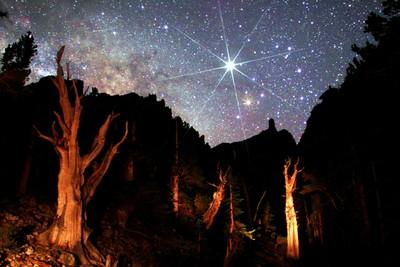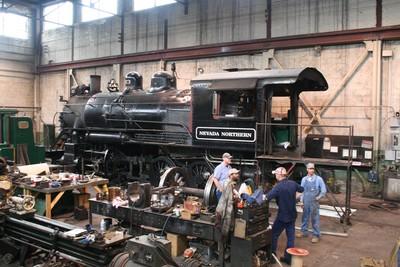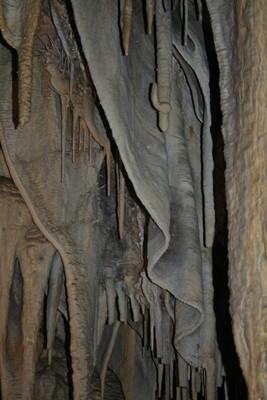CERCA: Where the People Aren’t



While many love to visit national parks, summer trips can turn into an exercise in patience when we are faced with the high temperatures at some of those parks and the heavy traffic and crowds at even more. But the situation is quite the opposite at Nevada’s Great Basin National Park. Even now, at the height of its busiest season, you can find cool weather, open roads and solitude.
Our group of four came to this remote area of eastern Nevada to camp, hike, descend into a cavern and relax under some of the clearest night skies in America. We also enjoyed daytime temperatures in the 70s and nights in the 50s.
Nevada’s only national park was established in 1986 and encompasses 77,100 acres in the southern Snake Range near Nevada’s eastern border. It includes the state’s second-highest mountain, Wheeler Peak, which reaches 13,063 feet toward the sky.
After a quick stop in tiny Baker to grab some last-minute supplies, we headed up the access road and into the park. From there we turned onto the steep and winding, 12-mile, Wheeler Peak Scenic Drive. In less than half an hour we gained about 3,400 feet in elevation and traveled through a multitude of plant habitats. From the dry desert shrub and sagebrush-covered valley floor near Baker we traveled through a pinyon juniper woodland and up to a subalpine forest of Englemann spruce and limber pine, intermixed with aspen.
There were many campground choices in the park but we chose to stay at the Wheeler Peak Campground, the highest in the park, at an elevation of 9,886 feet. This not only guaranteed us cool weather but also easy access to the trailheads of some of the best hikes, such as Wheeler Peak, Bristlecone-Glacier and the Alpine Lakes Loop trails.
We were pleasantly surprised to find lots of open campsites and settled into one spacious enough for our two tents and canopied by trees, next to Lehman Creek.
Great Basin’s remote setting and high elevation afford visitors not only excellent air quality but also low light pollution; the dark, clear skies make the place ideal for stargazing. That evening we happened to meet photographer Wally Pacholka, who was camping in a site across from ours. Pacholka came to the park from his home in Southern California specifically to shoot Great Basin’s night sky, and as we headed off to bed, Pacholka headed up the Bristlecone-Glacier Trail.
And a happy man he was the next morning.
“It was just spectacular; the skies last night were darker than I have ever seen them,” he said. Pacholka said he has been shooting night skies for 43 years, publishing his work in National Geographic, Time and Life, and is a three-time winner for Time-Life Picture of the Year.
Since it was our first full day at this elevation, we wanted to get acclimated before hiking anything too strenuous, so we chose the moderate Alpine Lakes Loop Trail. This was also a good choice for any group like ours, spanning many decades in age and outdoor experience. This three-mile hike not only provided stunning views up to Wheeler Peak, but also brought us past two glacial lakes and many streams.
We took the loop in a counterclockwise direction. At the beginning of the hike we passed many patches of wildflowers, including Jeffrey’s shooting stars, crimson columbine, mountain bluebells and, in one area directly next to a flowing spring-fed stream, we were treated to more than 100 Parry’s primrose in full bloom.
The area was also a magnet to dozens if not hundreds of multicolored butterflies. More than 100 species of butterflies can be found in the park, including gossamer-winged, swallowtails, fritillaries, skippers and monarchs. Some of these delicate insects travel hundreds of miles to reach the park, and if you visit from mid-July through early August, you will find the heaviest concentrations.
Along the trail we also saw plenty of wildlife, including an abundance of mule deer, golden-mantled ground squirrels, broad-tailed hummingbirds and Clark’s nutcrackers. This nutcracker has one remarkable habit. In fall, they collect the ripened limber and pinyon pine seeds so abundant in the park, and cache them in various places in the ground. When winter sets in and other species are long gone, these nutcrackers stick around, surviving by tapping into their hidden supplies. One bird may store as many as 100,000 nuts.
After leaving a forested area, we headed through a thick stand of aspen, then a broad meadow and arrived at Stella Lake. Stella is a glacier lake that lies directly below Wheeler Peak. Depending on the snow melt, the lake’s depth varies. As a result of our long drought, it was not filled to capacity, yet was still breathtaking and crystal clear.
We continued on and down to Teresa Lake, and soon after came to the junction with the Bristlecone-Glacier Trail. This trail is a good one to add as a side trip if you have time.
It has two unique features. The first is a grove of ancient bristlecone pines. The Great Basin bristlecones trees are some of the oldest trees on earth, many reaching ages from 3,000 to 4,000 years old. One found near Wheeler Peak in 1964 was dated to be more than 4,900 years old. Sadly, it was cut down and sectioned for more accurate dating before this area gained national park status. A cross-section of that tree is on display in the Lehman Caves Visitor Center.
The second feature worth seeing is Wheeler Glacier, the only glacier between the Wasatch Mountains in Utah and the Sierra Nevada of California.
After our morning hike we headed back down the scenic drive to the Lehman Caves Visitor Center and took a ranger-led tour. This was my second visit to the cave but this time there were only six other visitors along, compared to some 20 on my last visit. The cave, a limestone solution cavern, is one of 43 found in the park, but the only one open to tours. No matter when you visit, the temperature remains at a constant 50 degrees, and the humidity 90 percent.
Although there is evidence that American Indians knew of Lehman Caves, it was their discovery in 1885 by Absolom Lehman, a rancher and miner, that brought it to national attention when he started offering tours.
This cavern is highly decorated; practically every inch is covered with stalactites, stalagmites, columns, draperies or the curly formations called helictites. There are shield formations, made up of circular plates attached to each other. Rare elsewhere, there are more than 300 in Lehman Caves, each a bit different from the next. They look somewhat like clam shells standing on edge, some appearing quite smooth while others have stalactites and draperies hanging from them.
On our last morning in the park we headed down the scenic drive, stopping to hike a segment of the Osceola Ditch. Not a very inviting name for a trail, but it was an interesting look into the enterprising spirit and hard work of gold miners in the late 19th century. At that time, miners constructed an 18-mile flume to divert water from these mountains to ore-processing mills in the now-abandoned town of Osceola, near what is now the park’s northern boundary.
Days in the outdoors had whetted our appetite for a taste of such amenities as real beds and showers, but we weren’t ready to return to the blistering heat and bustle of Southern Nevada. Ely, more than 6,000 feet in elevation and just big enough with a population of 7,000, provided an agreeable alternative well worth the 27-mile side trip off the most direct route home.
Our first order of business was taking a leisurely ride on the Nevada Northern Railway. This is a must when visiting Ely, for railroad buffs call this one of the best-preserved short lines in the West.
We chose to sit in the open-air car. In just minutes, we were heading east toward the Schell Creek Range. Most of the land was BLM-managed and still lightly inhabited and scenic.
We stayed that night in the Nevada Hotel, built in 1929. Even if you aren’t staying there, it is worth a look inside at the lobby and casino area. Every inch of wall space is covered with trophies from stuffed animal heads to displays on rattlesnakes, weapons and buffalo as well as photos of movie stars and dignitaries.
The rooms are clean and standard-sized with all modern conveniences except a steady supply of hot water. When showering you have to be careful, as the water temperature fluctuates between freezing and extremely hot within seconds. The hotel is aware of the problem and in my bathroom there was a sign that read,
“The Hotel Nevada’s hot water
does not behave like it ought ‘ter.
A man who stayed there, was caught unaware
and is no longer a son, but a daughter.”
Ely is called the “City of Murals.” We took a short self-guided tour around town, visiting more than 20 outdoor murals and sculptures in the 11-block downtown area. The Ely Renaissance Society, in an effort to bring more culture and fine art to the community, was the driving force behind this outdoor art gallery. The murals include depictions of Ely’s ethnic groups, such as Basques who came largely as sheepherders, early cattle days, the Pony Express and the railroad.
Even in midsummer, temperatures were so moderate that strolling around this friendly, uncrowded little city was all pleasure.
And that was the pace of the whole trip. The most telling facts I uncovered in my research were these: Great Basin National Park has approximately 78,000 annual recreation visitors. Compare that to last year’s 2.5 million visitors to Zion National Park, and you can visualize the experience awaiting you at Great Basin.
GETTING THERELocation: Great Basin National Park, in east central Nevada near the Utah border, about 295 miles from Las Vegas.
Directions: From Las Vegas take Interstate 15 north for 21 miles, exiting onto U.S. 93 north, the Great Basin Highway. Drive about 234 miles and turn right onto U.S. Highway 50. Drive about 30 miles and go right onto Nevada Route 487. Go about five miles into Baker and take a right onto State Route 488, the five-mile access road into Great Basin National Park.
Directions from Great Basin National Park to Ely: From Baker, take Nevada Route 487 north for about five miles and go left onto U.S. Highway 50. Go west for about 56 miles to Ely.
Great Basin National Park: No general entrance fee is required, but there are individual user fees for visiting Lehman Caves and for camping. The Great Basin Visitor Center and Lehman Cave Visitor Center are open daily year-round, Memorial Day through Labor Day, 8 a.m.-5:30 p.m. with shorter hours the rest of the year. Closed Thanksgiving, Christmas and New Years Day. (775) 234-7331, www.nps.gov/grba.
Developed campgrounds: There are five campgrounds in the park, including one just for groups. All sites have picnic tables, tent pads and campfire grills. All campsites except the group site are first-come, first-served. Lower Lehman Creek Campground is open year-round, Upper Lehman Creek and Baker Creek campgrounds are open May-October and Wheeler Peak Campground is open June-September. Grey Cliffs Group Campground is open through Labor Day and reservations are required. (775) 234-7331, ext. 213.
Primitive camping: Facilities are available along Snake Creek and Strawberry Creek roads. All sites have picnic tables and fire grates. Overflow camping is available in neighboring U.S. Forest Service or BLM areas.
Bicycles: Allowed only on designated motor vehicle roadways.
Hazards: Many trails reach elevations above 10,000 feet, requiring caution regarding altitude sickness and thunderstorms.
Weather: Snow can fall any month in the park.
Lodging: Silver Jack Inn at Baker, five miles from park, has seven rooms, three efficiencies and RV spaces, café and patio dining. (775) 234-7323, www.silverjackinn.com.
Border Inn: A 24-hour, full-service stop 13 miles from the park on the Utah/Nevada border. It has a no-frills motel, cafe, gasoline, ATM and small convenience store. (775) 234-7300, www.greatbasinpark.com.
Gasoline: Baker Ranch Service Station in Baker has self-serve gasoline and diesel available 24 hours (credit or debit card required).
Lehman Caves: Tours run periodically every day from 9 a.m. to 3 p.m. The one-hour tours are $8 for adults, $4 age 5-15. Longer tours are available. Closed Christmas, Thanksgiving and New Year’s Day. Reservations are recommended during summer and may be purchased up to one month before the date of the tour. For complete program, schedule and tickets call (775) 234-7331, ext. 242.
ELY
Historic Hotel Nevada: Rooms from $35 nightly at 501 Aultman St. in downtown Ely, (888) 406-3055, www.hotelnevada.com.
White Pine Public Museum: 2000 Aultman St., Ely, (775) 289-4710.
Nevada Northern Railway: Steam and diesel locomotive excursions on two routes, plus museum and tours. 1100 Avenue A (11th St. East and Avenue A), Ely (775) 289-2085, http://www.nevadanorthernrailway.net.
Ward Charcoal Ovens State Park: About 25 miles southeast of Ely via U.S. 93. Open year-round. Day hiking, campground and fishing in Willow Creek. The park has an elevation range of 7,000-8,000 feet. www.parks.nv.gov.












